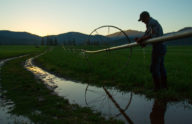How federal agencies rig the system
One of the most fundamental rights of American citizens is the right to seek redress from illegal government action in a court of law. But the federal government has an arsenal of weapons it wields to deny or curtail this right. Nowhere is this more prevalent than in the government’s attempts to stifle landowner suits challenging federal agency action under the Clean Water Act.
When a landowner challenges the federal government’s legal authority to regulate local land or water use under the act, the government response is as predictable as night follows day. First, the government attacks the landowner’s standing to bring the suit arguing the landowner suffered no unique harm from the agency’s illegal conduct. If that does not work, the government argues the landowner has not exhausted all administrative remedies or the case is not yet ripe for judicial review because the agency action is not final. Failing that, the government may argue the courts owe the agency complete deference in its interpretation of the law and its “expert opinions” should not be disturbed. This is the modern administrative state at work.
The EPA employed these tactics against the Sacketts when they sought judicial review of an EPA “compliance order” directing the Sacketts to cease all work on the construction of a modest home they intended to build on an apparently dry half-acre lot in a built-out subdivision that only a bureaucrat would call a navigable “water of the United States.” The Corps of Engineers relied on similar arguments in seeking dismissal of suits brought by Hawkes Company and Kent Recycling when they went to court to overturn blatantly invalid “jurisdictional determinations” issued by the Corps that allowed the government to stop certain wetland projects the government opposed.
In each of these cases, the landowners sought only one thing–their constitutional right to their day in court. For over forty years, the courthouse doors were closed to landowners who simply wanted a court of law to declare whether the federal government had the power to dictate the use of their land under the Clean Water Act when it was apparent the government had gone too far and exceeded its statutory or constitutional authority. This attempt to stifle citizen access to the courts is a breach of the public trust. It elevates the subjective values of government officials, which are not protected by the constitution, above the rights of American citizens, which are protected by the constitution. In short, when illegal government action is exempt from judicial review, government officials become a law unto themselves. This cannot be tolerated in an orderly society.
Fortunately, in each of these PLF cases–Sackett, Hawkes, and Kent Recycling–the U.S. Supreme Court unanimously held that landowners could exercise their right to seek redress in the courts in the face of overreaching government actions under the Clean Water Act. But this was not enough to deter the government from seeking to curtail judicial review of the Corps’ and EPA’s controversial “waters of the United States” or “WOTUS” rule issued in 2015 that broadly redefined the scope of the Clean water Act. That rule may well be the broadest expansion of federal power in the history of the Nation. Contrary to the Clean Water Act’s plain language, Supreme Court cases interpreting the act, and long-held constitutional limits on federal power, the WOTUS rule authorizes complete federal control of virtually “every wet spot in the country, ” as one Supreme Court justice put it, and great swaths of land throughout the country.
When PLF challenged the rule in district court, representing eleven landowners from seven states, the government sought to have the case dismissed claiming the proper venue for such a challenge is the Court of Appeals. This would have the effect of narrowing the window for challenging the WOTUS rule, and rules like it that define federal jurisdiction under the act, to 120 days, instead of the usual 6 years afforded review in the district courts.
Last week, the Supreme Court heard oral argument on this very issue. The audio and transcript of the hearing are available at the Supreme Court website (National Association of Manufacturers v. Department of Defense, Case No. 16-299). The justices appeared to side with Petitioner National Association of Manufacturers, PLF, and the States, that the text of the Clean Water Act is clear and does not support the government’s interpretation. Several justices were concerned that the government’s interpretation, which relies on a “practical reading” of the act, rather than on an “ordinary reading” of the act, would cause confusion because no one could rely on the plain text to determine when and where they could challenge the WOTUS rule. Chief Justice Roberts expressed the concerns raised by PLF that the the government’s narrow reading would harm landowners who may not know for several years whether the WOTUS rule even applies to them. They would be cut off from directly challenging the rule, and federal jurisdiction, if they missed the short 120-day window the government urged on the court. The primary reason the government gave for its crabbed reading of the act is that it would be more efficient for the government and the courts if challenges to the WOTUS rule were funneled through a single appeals court rather than multiple district courts throughout the country. However, the Petitioner countered that the Supreme Court held in PLF’s Sackett case that administrative efficiency and convenience does not trump the People’s right to meaningful access in the courts to counter overreaching government.
It is likely the High Court will rule in favor of landowners and that a decision will be issued soon so that the parties are clear about which court has jurisdiction to review the WOTUS rule which is still on the books but is undergoing revision as directed by Executive Order.



